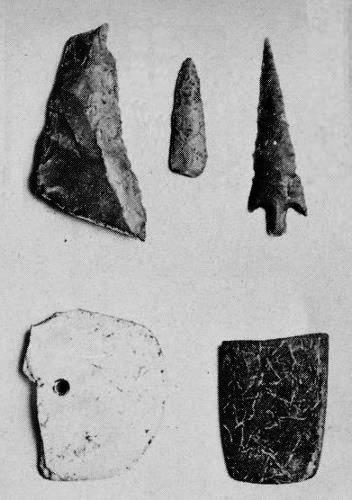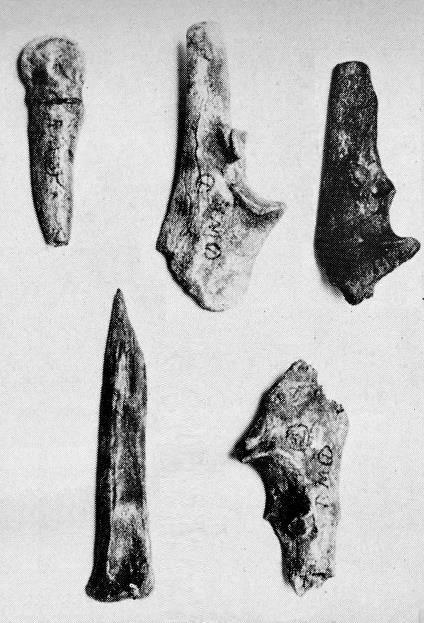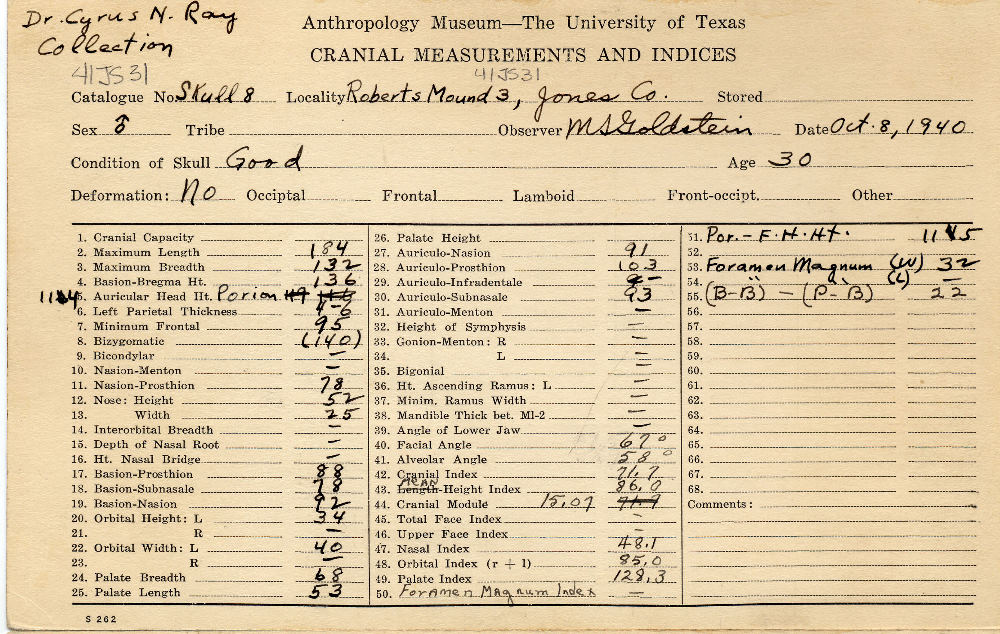Site 41JS31 |
Segments of incised, tubular bone beads found in the neck area of a young woman buried in Cairn Number 2 at 41JS31. Made from what appeared to be turkey humeri, the beads likely were strung as a necklace or clothing adornment. Inset from Ray 1933: Plate 8. |
Situated on a high, grassy ridge overlooking the Clear Fork of the Brazos River, this cemetery site contained four complex cairn burial features. The remains of 20 individuals were identified, some showing signs of violent death, and some accompanied by grave offerings. The four cairns were located within close proximity to one another within an area littered with camp debris. Cairn Number 1 was situated on top of the hill, Number 2 some 100 feet to the west, Number 3 ca. 200 yards south of Number 1, and Number 4 roughly 100 feet northeast of Number 3. Of the four, all but one contained multiple burials. The site was excavated periodically by Cyrus Ray and others throughout 1929-1937. In articles published in the Bulletin of the Texas Archeological and Paleontological Society (BTAPS), Ray variously termed the features “Covered Mound,” “Rock Mound Burial” and “Stone Slab Cist Mound Burials.” The term cairn is used here. Cairn Number 1 contained five individuals buried in four graves. The first (1A) was a cluster of small bone and teeth fragments from a cremation. Ray observed that the burned bone fragments were “in such oval symmetrical form as to suggest it originally rested in a bag” or other perishable container. The age and sex of the individual was not determined, although Ray described the interred as an infant in one BTASP article. The remains had been placed in a pit and covered with a horizontal stone slab about 3 feet below the surface. A few mussel shells were then placed atop the slab. Several large vertical slabs were set close together on top of the stone covering, and these extended above ground surface. A second burial (1B) in the western portion of the mound contained a similar arrangement of stone slabs. Underneath a square flat covering stone lay two flexed adult skeletons, one directly on top of the other, and aligned in opposite directions. Both apparently had been interred together, with the rock slab covering only their torsos. The upper individual was an adult (sex unreported) who had been placed on right side, with head to the south and facing east. The lower individual, a male roughly 35-54 years old, had been placed on his left side, with head to the north, facing east. In addition to the human remains, mussel shell fragments were found “here and there,” according to Ray. Burial 1C was located in the southeastern portion of the mound and contained an arrangement of rock similar to those in 1A and 1B, with a horizontal slab covering only the body portions. The grave held the flexed remains of two individuals, an infant and a probable adult female, along with varied grave offerings. The infant lay on its left side with head to the north and facing east. The adult was placed with head to the north, and facing south. Five unmodified mussel shells lay near the long bones, which were against the chest. Near the left shoulder was a cache of items, likely held originally in a perishable container, such as a leather pouch or net bag. Among these were deer antler tools (flakers, awls); a quartzite abrading stone; a triangular chert biface; and chert scraper. Both the stone tools were patinated. Cairn Number 2 held two individuals, an infant and probable adult female, placed in flexed positions with heads to the west. A slab had been laid horizontally over the torsos, about 3 feet deep in the grave; additional slabs were then placed vertically atop the slab cover, in an arrangement similar to Cairn Number 1. The adult reportedly lay on left side with head facing north. Incised bone beads, probably made of turkey humeri, were found under the jaw bone and may have been strung on a necklace. Bones of the infant were in poor condition. Cairn Number 3 contained eight flexed burials (3A, B, and C; 3F, G, H, I, and J) and two bundle burials (3D and E). The first three flexed burials were found in stone slab cists buried four feet deep. Age and sex of the flexed burials were not reported but were likely adults. A possible bison bone (cuboid-navicular) was recovered from one grave. Cairn 3D contained parts of a skull and a bundle of bone fragments lying under a top layer of stone. Cairn 3E, found nearby, at a depth of about 15 inches, contained a skull and bundle of bones, as well as an arrow point in the center of the ribs. As shown in the photo at top right, the point was a long, slender type Moran, with a parallel-sided stem. Below the two bundle burials were five additional flexed burials, each apparently within a separate pit covered with a separate horizontal slab. Atop each of the five slabs, stones had been placed in vertical alignment for about three feet. A single grave inclusion, a bone awl, probably from a deer or antelope metapodial, was found with one individual. Interestingly, the mandibles, or jaw bones, were missing from five of the 10 skeletons in Cairn 3. This may reflect a ritualized pattern—such as the taking of symbolic war trophies. Based on cranial data on four skulls from Cairn 3 studied by physical anthropologist M. S. Goldstein, two were males, about 30 years old; one was a roughly 25-year-old female with a partially healed gash over one eye; and the fourth was a child roughly 3 years of age of indeterminate sex. An eleventh burial (3K), excavated in 1937, was described as an additional cist containing remains of another skeleton, in a poor state of preservation. Ray reported the bones had been gnawed on and scattered by rodents, and the remaining bones were too fragmentary to reconstruct. Cairn Number 4 was a relatively shallow slab cist burial of a single individual, placed in a flexed position. Bones were poorly preserved and no age or sex information was reported. Against and outside of the right forearm wrist area were a fragmentary marine conch shell pendant with a central perforation and decorations on edge, and a fragmentary polished stone artifact, described as a boatstone or atlatl weight. |
|


